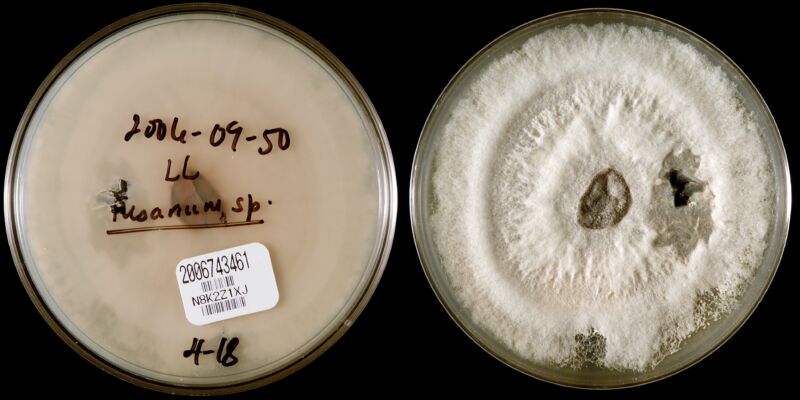Global Warming: The Potential For Increased Fungal Pathogen Spread

Table of Contents
The Impact of Climate Change on Fungal Growth and Distribution
Climate change significantly influences fungal growth and distribution. Rising temperatures and increased humidity, two hallmarks of global warming, create ideal conditions for fungal reproduction and survival. These changes directly impact the geographic range expansion of various fungal pathogens.
- Increased average temperatures extend the growing seasons for many fungi, allowing them to proliferate for longer periods.
- Higher humidity levels promote spore germination and dispersal, facilitating the spread of fungal infections over wider areas.
- Changes in rainfall patterns can also influence fungal development, with some species thriving in wetter conditions while others are affected negatively. This variability adds complexity to predicting the impact of climate change on specific fungal species.
- Geographic range shifts are a significant concern. Warmer temperatures are allowing many fungal pathogens to thrive in previously unsuitable regions, exposing new populations to potential infection.
- Examples include the expansion of Coccidioides species, causing coccidioidomycosis (valley fever), into higher altitudes and latitudes, and the increased incidence of histoplasmosis in areas with changing environmental conditions.
Increased Incidence of Fungal Infections in Humans and Animals
The consequences of climate change-driven fungal expansion are already being observed through an increased incidence of fungal infections in both humans and animals. This is particularly alarming for immunocompromised individuals, such as those with HIV/AIDS, organ transplant recipients, or those undergoing cancer treatment, who are more susceptible to opportunistic fungal infections.
- Cases of histoplasmosis, coccidioidomycosis, and other fungal diseases are on the rise globally in regions experiencing shifts in temperature and humidity.
- The risk for severe and widespread outbreaks is significantly increased, posing a substantial challenge to public health systems.
- The development of antifungal resistance further complicates the issue, limiting treatment options and necessitating the discovery of new antifungal drugs.
- Livestock and wildlife populations are also impacted. Fungal infections can cause significant mortality and morbidity in these populations, affecting food security and ecosystem stability.
The Role of Vector Organisms in Fungal Pathogen Spread
Many fungal pathogens rely on vector organisms, such as insects and arthropods, for their spread. Climate change influences vector populations and distribution, exacerbating fungal disease transmission.
- The expansion of insect vector habitats, driven by warmer temperatures and altered rainfall patterns, leads to increased opportunities for pathogen transmission.
- Changes in insect behavior, including increased activity and extended breeding seasons, can further amplify the spread of fungal diseases.
- Certain plant diseases, impacting food security, are exacerbated by the expansion of insect vectors carrying fungal pathogens affecting crops.
Economic and Environmental Consequences
The economic and environmental consequences of increased fungal pathogen spread are far-reaching.
- Crop losses due to fungal diseases represent a significant economic blow to agriculture and food security.
- Increased healthcare costs associated with treating fungal infections place a burden on public health systems.
- Ecosystem disruption resulting from fungal pathogen outbreaks causes ripple effects throughout the natural world.
- Loss of biodiversity due to fungal diseases affecting plant and animal populations further diminishes the resilience of our ecosystems.
Conclusion
The evidence overwhelmingly demonstrates a strong link between global warming and the increased threat of fungal pathogen spread. Rising temperatures, humidity, and changes in rainfall patterns create ideal conditions for fungal growth and distribution, leading to increased incidence of fungal infections in humans, animals, and ecosystems. The economic and environmental consequences are substantial and demand urgent attention. We must prioritize research into fungal pathogen dynamics under changing climates, improve public health surveillance systems, develop innovative antifungal treatments, and, critically, address the root cause – climate change itself. Understanding the impact of global warming on fungal pathogens and mitigating the spread of these pathogens in a warming climate requires a concerted global effort. Let's act now to protect our health and our planet.

Featured Posts
-
 Moto Gp Inggris Link Live Streaming Race Sprint Jam 20 00 Wib
May 26, 2025
Moto Gp Inggris Link Live Streaming Race Sprint Jam 20 00 Wib
May 26, 2025 -
 Problemes Techniques Rtbf Enquete Sur Les Dernieres Pannes
May 26, 2025
Problemes Techniques Rtbf Enquete Sur Les Dernieres Pannes
May 26, 2025 -
 The Saint Itv 4 Tv Listings And Air Times
May 26, 2025
The Saint Itv 4 Tv Listings And Air Times
May 26, 2025 -
 Hoka Cielo X1 2 0 Review Lightweight Rocker For Speedier Runs
May 26, 2025
Hoka Cielo X1 2 0 Review Lightweight Rocker For Speedier Runs
May 26, 2025 -
 Record Breaking Sales Carolina Country Music Fest 2025 Sold Out
May 26, 2025
Record Breaking Sales Carolina Country Music Fest 2025 Sold Out
May 26, 2025
